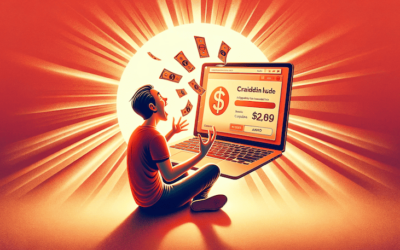Marketing has always been about grabbing the attention of your target audience.
But in today’s fast-paced digital world?
It’s become increasingly difficult to stand out.
But there’s one tool that has been powerful in marketing for centuries.
FEAR.
But guess what?
It’s a double-edged sword.
While it can motivate people to take action, it can also backfire and damage your brand’s reputation.
In this blog post, you’ll learn about the power of fear in marketing and how you can use it to make an impact (without crossing the line).
Contents
The Science of Fear in Marketing
Fear is a natural human emotion, and it can be a powerful motivator.
When used correctly, fear can be an effective tool in marketing.
I mean… there’s a reason it has been used for centuries, and its effectiveness has been proven time and again.
Fear marketing usually focuses on a specific threat or danger that could affect the consumer.
The goal?
To create a sense of urgency and motivate consumers to take action to protect themselves from the perceived threat.
How does it work?
Fear-based marketing works by triggering the amygdala.
It’s part of the brain responsible for processing emotions such as fear, anxiety, and stress.
When the amygdala is activated, it can override the rational part of the brain, making people more likely to take action.

Fear-based marketing campaigns often use dramatic imagery, emotional language, and alarming statistics to create a sense of urgency and encourage people to take action.
The psychology behind fear-based marketing
Fear-based marketing campaigns tap into the basic human survival instincts that are hard-wired into our brains.
When we perceive a threat, our body’s fight or flight response is activated.
This makes us more alert, focused, and ready to take action.
This instinct is used to create a sense of urgency and motivate people to take action.
Example of a fear-based marketing campaign that worked
The American Legacy Foundation’s “Truth” campaign used fear-based messaging to discourage teenagers from smoking.
Can you see how this was successful in reducing smoking rates among teenagers?
But hey, it’s not all sunshine and rainbows.
The Dangers of Fear Marketing
Yes, fear-based marketing can be an effective tool in motivating people to take action.
But guess what?
It also comes with risks.
When not handled carefully, it can backfire and have negative effects on your brand’s reputation.
When can fear-based marketing go wrong?
Well, it can go wrong in several ways.
Firstly, fear-based marketing campaigns can be too extreme or graphic, which can cause consumers to become desensitized or overwhelmed.
This can cause them to tune out and ignore the message entirely.
Secondly, fear-based marketing campaigns can be misleading or dishonest, which can lead to backlash and damage to the brand’s reputation.
Lastly, fear-based marketing campaigns can create anxiety and fear in consumers, which can be harmful to their mental health and well-being.
All of which are not good for your brand.
Negative effects of fear marketing on your brand
When fear-based marketing campaigns go wrong, they can have negative effects on your brand’s reputation.
Fear-based marketing campaigns that are too extreme or misleading can cause consumers to lose trust in the brand.
This can lead to a decrease in sales, negative reviews, and a damaged reputation.
Additionally, fear-based marketing campaigns that create anxiety and fear in consumers can lead to negative associations with the brand and a decrease in brand loyalty.
Example of a fear-based marketing campaign that backfired
The “Got Milk?” campaign.
(Fun fact: I took the advertising & creativity masterclass by Jeff Goodby and Rich Silverstein, who were the creators of this campaign)
This is just one ad from the campaign.
There were many others.
This campaign was criticized for being misleading and was ultimately discontinued.
This brings us to…
How to Use Fear Marketing Effectively
Fear-based marketing can be a powerful tool when used effectively.
How?
By understanding the risks and using fear-based marketing responsibly.
This way you can create campaigns that motivate people to take action without crossing the line into fear-mongering or manipulation.
So, here are some tips on how to use fear marketing effectively.
Understand your audience
To use fear-based marketing effectively, you need to understand your audience and what motivates them.
Different audiences respond differently to fear-based messaging.
So it’s important to tailor your message to your specific audience.
Conduct market research and use customer feedback to gain insights into what motivates your audience and what fears they may have.
Identify the specific threat or danger
To use fear marketing effectively, you need to identify the specific threat or danger that your campaign is addressing.
This will help you create a clear and focused message that resonates with your target audience.
It’s important to make sure that the threat is REAL and relevant to your target audience.
DO NOT CREATE A FAKE THREAT.
Use emotional language and imagery
Emotional language and imagery can help create a sense of urgency and motivate people to take action.
Use language that evokes emotions such as fear, anxiety, and stress.
Use imagery that is dramatic and attention-grabbing, but not too extreme or graphic.
Use facts and data
To avoid being accused of fear-mongering or misleading messaging, it’s important to use facts and data to support your message.
Back up your claims with credible sources and avoid exaggerating or making unsubstantiated claims.
This will help build trust with your audience and strengthen your message.
Offer a solution with clear call-to-action
Fear-based messaging can be overwhelming for consumers, so it’s important to offer a solution to the perceived threat.
Offer a clear and actionable solution that consumers can take to protect themselves from the perceived threat.
This will help to alleviate anxiety and fear and provide a sense of control.
For this, a clear call to action is essential.
It tells the consumer what action they need to take to protect themselves from the perceived threat.
Make sure that the call-to-action aligns with the overall message of the campaign.
But is fear-based marketing your only option?
Nope.
Alternatives to Fear Marketing
While fear-based marketing can be effective, it is not the only way to make an impact.
What if fear-based marketing is not the right fit for your brand?
Well, there are several alternatives that can be just as effective in motivating consumers to take action.
Empathy-Based Marketing
Empathy-based marketing focuses on understanding the consumer’s needs and desires and creating messaging that speaks to those needs in a compassionate and understanding way.
This approach can be effective in building trust and connection with consumers, which can lead to increased brand loyalty and sales.
Positive Messaging
Another alternative to fear marketing is to use positive messaging.
Rather than using fear to motivate consumers, positive messaging focuses on the benefits of taking action.
Positive messaging can create a sense of optimism and hope, which can be just as powerful as fear in motivating action.
For example, a campaign that promotes the benefits of recycling can be more effective than a campaign that focuses on the negative effects of not recycling.
Education-Based Marketing
Education-based marketing focuses on providing consumers with useful information that can help them make informed decisions.
This approach can be effective in building trust and credibility with consumers and can help to position your brand as a thought leader in your industry.
Humor-based Marketing
Humor is another alternative.
Humor can be used to capture attention and create a positive association with the brand.
Humorous campaigns can be memorable and shareable, which can increase their reach and impact.
For example, a campaign that uses humor to promote safe driving can be more effective than a campaign that uses fear-based messaging.
Also Read: What is a full-funnel marketing strategy + a unique approach
Final Thoughts
Fear is a powerful tool in marketing.
While fear-based marketing can be effective, it is important to use it responsibly.
By understanding the science behind fear-based marketing, identifying your target audience’s pain points, and finding the right balance between motivation and manipulation, you can make an impact without crossing the line.
Finding the right balance between fear-based marketing and alternative approaches can lead to the most effective campaigns.
Remember, use fear-based marketing responsibly, keeping in mind the potential risks and consequences.
Ready to beef up your marketing, build a distinct + memorable brand, wow your customers, and confuse your competitors?
Book your free strategy call, and let’s have a chat.





0 Comments